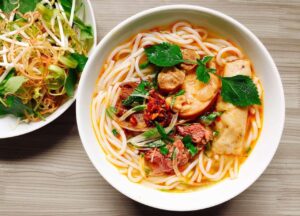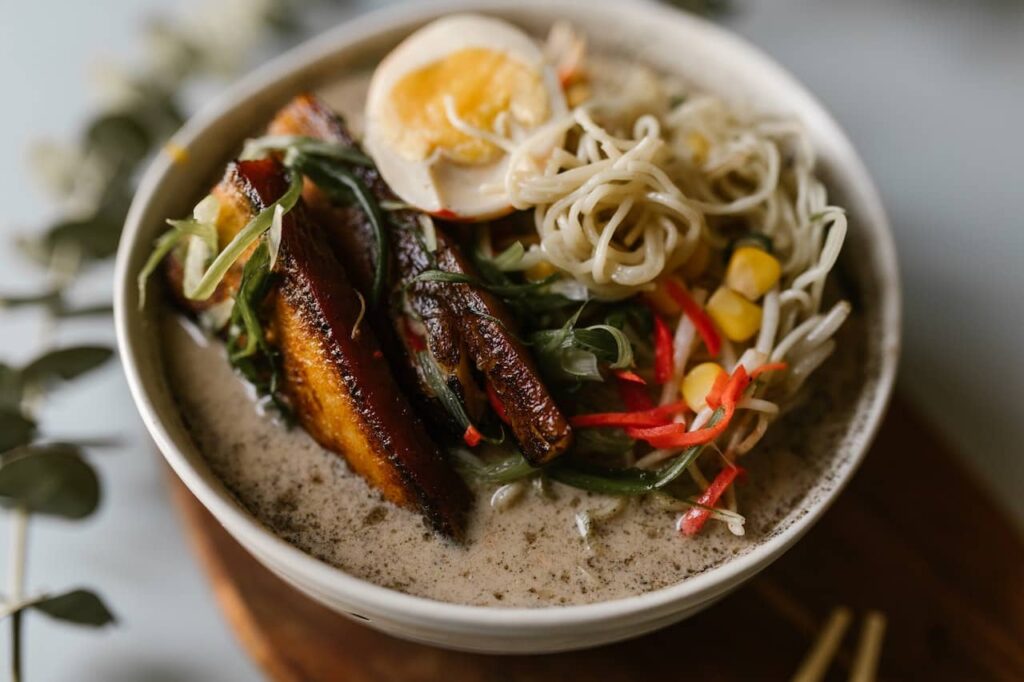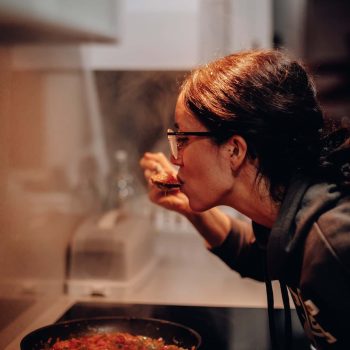
Ramen (/ˈrɑːmən/) (拉麺, ラーメン or らーめん, rāmen, IPA: [ɾaꜜːmeɴ]) is a Japanese noodle dish. It consists of Chinese-style wheat noodles (or 中華麺, chūkamen) served in a broth; common flavors are soy sauce and miso, with typical toppings including sliced pork (chāshū), nori (dried seaweed), menma (bamboo shoots), and scallions. Ramen has its roots in Chinese noodle dishes. Nearly every region in Japan has its own variation of ramen, such as the tonkotsu (pork bone broth) ramen of Kyushu and the miso ramen of Hokkaido.
Origin
Ramen is a Japanese adaptation of Chinese wheat noodle soups and was first recorded to have appeared in Yokohama Chinatown. Although the ramen takes its name from lāmiàn, it does not actually evolve from the northern Chinese dish of lamian. The noodles used in ramen known as “chūkamen” are cut rather than hand-pulled. The ramen is derived from southern Chinese noodle dishes such as the char siu tangmian of Guangdong and the rousi tangmian of Jiangnan. This is reflective of Yokohama Chinatown’s demographics, as most Chinese settlers in the district came from the cities of Guangzhou and Shanghai.
One theory says that ramen was introduced to Japan during the 1660s by the Chinese neo-Confucian scholar Zhu Shunsui who served as an advisor to Tokugawa Mitsukuni after he became a refugee in Japan to escape Manchu rule and Mitsukuni became the first Japanese person to eat ramen. Most historians reject this theory as a myth created by the Japanese to embellish the origins of ramen.
According to historians, the more plausible theory is that ramen was introduced to Japan in the late 19th or early 20th centuries by Chinese immigrants living in Yokohama Chinatown. In 1910, the first ramen shop named Rairaiken [ja] (来々軒) opened in Asakusa, Tokyo, where the Japanese owner employed twelve Cantonese cooks from Yokohama’s Chinatown and served the ramen arranged for Japanese customers. Early versions were wheat noodles in broth topped with char siu.
By 1900, restaurants serving Chinese cuisine from Guangzhou and Shanghai offered a simple dish of noodles, a few toppings, and a broth flavored with salt and pork bones. Many Chinese living in Japan also pulled portable food stalls, selling ramen and gyōza dumplings to workers. By the mid-1900s, these stalls used a type of a musical horn called a charumera (チャルメラ, from the Portuguese charamela) to advertise their presence, a practice some vendors still retain via a loudspeaker and a looped recording. By the early Shōwa period, ramen had become a popular dish when eating out.[citation needed] According to ramen expert Hiroshi Osaki, the first specialized ramen shop opened in Yokohama in 1910.

Noodles
Most noodles are made from four basic ingredients: wheat flour, salt, water, and kansui (かん水) derived from the Chinese jiǎnshuǐ (鹼水) a type of alkaline mineral water, containing sodium carbonate and usually potassium carbonate, as well as sometimes a small amount of phosphoric acid. Although ramen noodles and Udon noodles are both made with wheat and are similar, they are different kinds of noodle.
The kansui is the distinguishing ingredient in ramen noodles, and originated in Inner Mongolia, where some lakes contain large amounts of these minerals and whose water is said to be perfect for making these noodles. Making noodles with kansui lends them a yellowish hue as well as a firm texture. Eggs may also be substituted for kansui. Some noodles are made with neither eggs nor kansui and should only be used for yakisoba, as they have a weaker structure and are more prone to soaking up moisture and becoming extremely soft when served in soup.
Ramen comes in various shapes and lengths. It may be thick, thin, or even ribbon-like, as well as straight or wrinkled.
Traditionally, ramen noodles were made by hand, but with growing popularity many ramen restaurants prefer to use noodle-making machines to meet the increased demand and improve quality. Automatic ramen-making machines imitating manual production methods have been available since the mid. 20th century produced by such Japanese manufacturers as Yamato MFG.

Soup
Ramen soup is generally made from stock based on chicken or pork, combined with a variety of ingredients such as pork bones, katsuobushi (skipjack tuna flakes), niboshi (dried baby sardines), beef bones, shiitake, onions, and kombu (kelp). Some modern ramen broths can also be vegetable-based. Tare is often added to broth to make the soup.
Tonkotsu (豚骨, “pork bone”; not to be confused with tonkatsu) soup is broth with a typically translucent white colored appearance. Similar to the Chinese baitang (白湯), it has a thick broth made from boiling pork bones, fat, and collagen over high heat for many hours, which suffuses the broth with a hearty pork flavor and a creamy consistency that rivals milk, melted butter or gravy (depending on the shop). Although Tonkotsu is merely a kind of broth, some people consider tonkotsu ramen (specialty of Kyushu, its birthplace) a distinct flavor category.
Torigara (鶏がら, “Chicken bone”) soup based on chicken bone broth originated mainly in Tokyo. It is often used as a base for salt and shoyu ramen.

Flavors
The resulting combination is generally divided into several categories. Although newer and older variations often make this categorization less clear-cut, a description of said old variations is as follows:
Shio (塩, “salt”) ramen is the oldest of the four types. It has a pale, clear, yellowish broth made with plenty of salt and any combination of chicken, vegetables, fish, and seaweed. Occasionally pork bones are also used, but they are not boiled as long as they are for tonkotsu ramen, so the soup remains light and clear. Chāshū is sometimes swapped for lean chicken meatballs, and pickled plums and kamaboko (a slice of processed fish roll sometimes served as a frilly white circle with a pink or red spiral called narutomaki) are popular toppings as well. Noodle texture and thickness varies among shio ramen, but they are usually straight rather than curly. “Hakodate Ramen” is a well-known version of shio ramen in Japan.
Shōyu (醤油, “soy sauce”) ramen has a clear brown broth, based on a chicken and vegetable (or sometimes fish or beef) stock with plenty of soy sauce added resulting in a soup that is tangy, salty, and savory yet still fairly light on the palate. Shōyu ramen usually has curly noodles rather than straight ones, although this is not always the case. It is often adorned with marinated bamboo shoots or menma, scallions, ninjin (carrot), kamaboko (fish cakes), nori (seaweed), boiled eggs, bean sprouts or black pepper; occasionally the soup will also contain chili oil or Chinese spices, and some shops serve sliced beef instead of the usual chāshū.
Miso (味噌) ramen have reached national prominence around 1965. This uniquely Japanese ramen, which was developed in Sapporo Hokkaido, features a broth that combines copious miso and is blended with oily chicken or fish broth – and sometimes with tonkotsu or lard – to create a thick, nutty, slightly sweet and very hearty soup. Miso ramen broth tends to have a robust, tangy flavor, so it stands up to a variety of flavorful toppings: spicy bean paste or tōbanjan (豆瓣醤), butter and corn, leeks, onions, bean sprouts, ground pork, cabbage, sesame seeds, white pepper, chilli and chopped garlic are common. The noodles are typically thick, curly, and slightly chewy.
Karē (カレー, “curry”) ramen is a relative newcomer, cooked with curry soup. In Japan, several cities claim to be its place of origin. The city of Muroran claims it originated there in 1965 (see also Muroran curry ramen), while the city of Sanjō city claims to have had kare ramen for over 80 years, and the city of Katori also claims to have been the site of its origin. Curry soup is mainly made with pork bones and vegetables and is seasoned with curry. The noodles are thick and curly. Toppings include chāshū, wakame, and bean sprouts.

Toppings
After basic preparation, ramen can be seasoned and flavored with any number of toppings, including but not limited to:
- Chāshū (sliced barbecued or braised pork)
- Negi (green onion)
- Takana-zuke (Pickled and seasoned mustard leaves)
- Seasoned (usually salted) boiled egg (Soy egg (“Ajitsuke Tamago”))
- Bean or other sprouts
- Menma (lactate-fermented bamboo shoots)
- Kakuni (braised pork cubes or squares)
- Kikurage (wood ear mushroom)
- Nori (dried seaweed)
- Kamaboko (formed fish paste, often in a pink and white spiral called narutomaki)
- Squid
- Umeboshi (pickled plum)
- Corn
- Butter
- Wakame (a type of seaweed)
- Olive oil
- Sesame oil
- Soy sauce
- Other types of vegetables
Preference
Seasonings commonly added to ramen are white pepper, black pepper, butter, chili pepper, sesame seeds, and crushed garlic. Soup recipes and methods of preparation tend to be closely guarded secrets.
Wikipedia contributors, “Ramen,” Wikipedia, The Free Encyclopedia, https://en.wikipedia.org/w/index.php?title=Ramen&oldid=1109022875 (accessed September 9, 2022).








